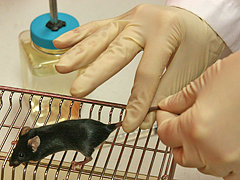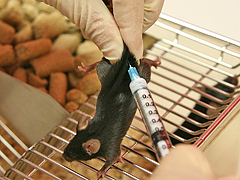EAE Induction by Active Immunization in SJL Mice
Please note: This protocol is for use with a discontinued product; it is for historical reference only.
This protocol is provided for use by customers continuing to use this product (available by special order).
All customers are encouraged to switch to the latest products for this application.
There are no advantages to the discontinued products.
Recommended protocol for use with the following Hooke Kits™
- Hooke Kit™ [Ser140]-PLP139-151/CFA Emulsion (EK-0120)
- Hooke Kit™ [Ser140]-PLP139-151/CFA Emulsion PTX (EK-0121)
- Hooke Kit™ [Ser140]-PLP139-151/CFA Emulsion PTXx2 (EK-0123)
Hooke Kit™ choice
[Ser140]-PLP139-151 induced EAE in SJL mice is sensitive to small variations in mice and laboratory environments. PTX has mixed effects on EAE development in SJL mice.
The following EAE incidence and relapse results are typically observed:
| Cat # | EK-0120 | EK-0121 | EK-0123 |
|---|---|---|---|
| EAE incidence | 80-100% | 80-100% | 90-100% |
| Relapse rate | 50-70% | 50-70% | 40-60% |
To obtain the highest incidence and severity of the first wave of EAE, we recommend immunization with EK-0123 using 10 to 12 mice/group.
For observation of incidence and severity of EAE relapses, we recommend immunization of 15 to 18 mice/group using EK-0120 or EK-0121, to ensure that enough mice will relapse for statistical analysis.
Summary
SJL mice develop relapsing-remitting paralysis after immunization with [Ser140]-PLP139-151 peptide emulsified in Complete Freund's Adjuvant. Mice develop EAE 10-14 days after immunization, but completely or partially recover within 7-10 days. Around 25-40 days after the immunization, approximately 50% of mice develop a second wave of paralysis (relapse).
Materials needed
| Qty | Description |
|---|---|
| 1 |
Hooke Kit™ [Ser140]-PLP139-151/CFA
Emulsion (EK-0120) or Hooke Kit™ [Ser140]-PLP139-151/CFA Emulsion PTX (EK-0121) or Hooke Kit™ [Ser140]-PLP139-151/CFA Emulsion PTXx2 (EK-0123) |
| 10 | SJL mice, females, 8 to 10 weeks old (Jackson Laboratory strain SJL/J) |





Method
Mice should be acclimated at your facility for at least 7 days before immunization.
Subcutaneous injection technique is important to successful EAE induction.
(Note: Photos illustrate C57BL/6 mice; the procedure is identical for SJL mice. These procedures are drafted for right-handed injection; reverse if injecting with the left hand.)
Grip mouse tail with finger and thumb of right hand (figure).
Restrain mouse against cage with three remaining fingers of right hand (figure).
With left hand, restrain mouse with two fingers behind head (figure).
Using right hand, inject mouse subcutaneously at 4 sites on the back of the mouse, with 0.05 mL of emulsion (syringe with white content) at each site:
- On upper back (figure).
- On upper back, approximately 1 cm away from the initial injection.
- On lower back (figure).
- On lower back, approximately 1 cm away from the previous injection.
After each injection, keep the needle inserted into the subcutaneous space for 10 to 15 seconds to avoid leakage of the emulsion. Alternatively, a light pull on the syringe plunger will prevent leakage.
Repeat (1–4) for all mice.
Only if using Hooke Kit™ LP139-151/CFA Emulsion PTX (EK-0121) or Hooke Kit™ [Ser140]-PLP139-151/CFA Emulsion PTXx2 (EK-0123):
Inject the pertussis toxin (syringe with clear filling) intraperitoneally within 2 hours of injection of the emulsion. Inject 0.1 mL per mouse.
Only if using Hooke Kit™ [Ser140]-PLP139-151/CFA Emulsion PTXx2 (EK-0123):
22-26 hours after injection of the emulsion, intraperitoneally inject the second dose of pertussis toxin into the mice; inject 0.1 mL of pertussis toxin (syringe with clear filling) into each mouse.
Check mice for signs of EAE daily (see EAE scoring), starting on day 7 after the immunization.
As soon as the first signs of paralysis occur, provide mice with food pellets and wet food on the floor of the cage, and easily accessible water. HydroGel (ClearH2O, Portland ME) may be used as a source of water during the most severe paralysis.
All mice will develop obvious bumps of emulsion at the injection sites 2 to 4 days after injection.
In some mice, alopecia will develop at the site of injection 5 to 7 days after injection.
In most mice, the emulsion will remain at the site of injection for the duration of the experiment (~30 days). Approximately 10% to 40% of the mice will clear the emulsion by developing skin ulcers at injection sites. Most of the time, these ulcers do not require treatment – they usually heal in a few days and scars form. If concerned, consult attending veterinarian. Antibiotic ointment may be applied.
EAE development does not correlate with mice clearing or not clearing emulsion from the injection site.
EAE Scoring
Typically, EAE is scored on scale 0 to 5:
| Score | Clinical observations |
|---|---|
| 0 |
No obvious changes in motor functions of the mouse in comparison to
non-immunized mice. When picked up by the tail, the tail has tension and is erect. Hind legs are usually spread apart. When the mouse is walking, there is no gait or head tilting. |
| 1 | Limp tail. When the mouse is picked up by the tail, instead of being erect, the whole tail drapes over your finger. |
| 2 | Limp tail and weakness of hind legs. When mouse is picked up by tail, legs are not spread apart, but held closer together. When the mouse is observed when walking, it has a clearly apparent wobbly walk. |
| 3 | Limp tail and complete paralysis of hind legs (most common). OR Limp tail with paralysis of one front and one hind leg. OR ALL of:
|
| 4 |
Limp tail, complete hind leg and partial front leg paralysis. Mouse is minimally moving around the cage but appears alert and feeding. Usually, euthanasia is recommended after the mouse scores level 4 for 2 days. When the mouse is euthanized because of severe paralysis, score of 5 is entered for that mouse for the rest of the experiment. |
| 5 | Complete hind and complete front leg paralysis, no movement around
the cage. OR Mouse is spontaneously rolling in the cage. OR Mouse is found dead due to paralysis. If mouse is alive, euthanize the mouse immediately if it scores 5. Once mouse is scored 5, the same score is entered for all the days for the rest of the experiment. |
Most researchers also give mice “in-between” scores (i.e. 0.5, 1.5, 2.5, 3.5) when the clinical picture lies between two defined scores.
Expected results
EAE will be induced, with onset of paralysis between 10 and 14 days after immunization, and mean maximum score of the first paralytic episode of approximately 2.5.
Even mice which develop very severe first wave EAE (score 4) will almost always show some recovery within 2 or 3 days. If mice are unable to reach water due to temporary paralysis, Ringer's solution should be administered subcutaneously.
Mean maximum score of the second paralytic episode will be 1.5 to 2.5.
Daily dosing of mice with a potential therapeutic often delays the onset of EAE and decreases severity of EAE due to stress of the procedures. Careful handling of the mice will minimize these effects. To reduce effects of stress, we recommend sham dosing, 7 and 4 days before immunization of the mice.
Version: 2010-04


_150px.jpg)